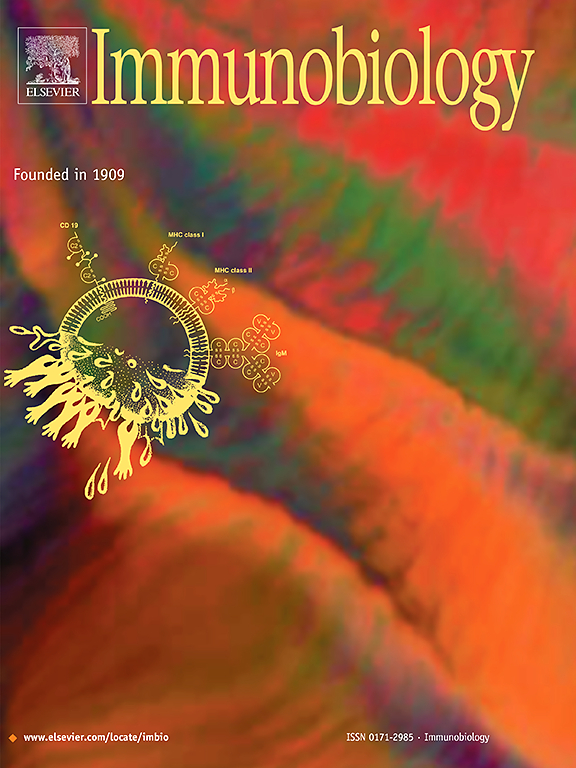可解释的机器学习揭示了PANoptosis在NAFLD诊断和分型中的作用
IF 2.3
4区 医学
Q3 IMMUNOLOGY
引用次数: 0
摘要
非酒精性脂肪性肝病(NAFLD)是一种全球性的健康挑战,其特点是发病机制复杂,治疗选择有限。新出现的证据表明,panoptosis(焦亡、凋亡和坏死的协调相互作用)是NAFLD代谢和免疫失调的关键驱动因素。在这里,我们整合了多个数据集和可解释的机器学习来揭示PANoptosis在NAFLD诊断、亚型分型和免疫微环境重塑中的作用。通过将差异表达基因与panoptoiss相关基因相交,鉴定出TRADD、CASP6、TNFRSF1A、TNFAIP3等9个枢纽基因,并通过SHAP分析和nomogram验证,构建了稳健的诊断模型(AUC = 0.976)。无监督共识聚类将NAFLD患者分为两种panoposis驱动亚型(C1/C2和CA/CB),揭示了不同的免疫细胞浸润模式和途径激活。单细胞测序进一步将枢纽基因定位到免疫细胞并揭示其细胞通讯,暗示其在NAFLD进展中的作用。分子对接研究确定福司他替尼和米诺环素是潜在的治疗候选者,而泛癌症分析显示TNFRSF1A过表达与多种癌症类型的不良预后相关。本研究增强了对PANoptosis作为NAFLD重要诊断和治疗靶点的认识,为免疫介导的发病机制提供了新的见解,并为治疗策略铺平了道路。本文章由计算机程序翻译,如有差异,请以英文原文为准。

Interpretable Machine Learning reveals the Role of PANoptosis in the Diagnosis and Subtyping of NAFLD
Non-alcoholic fatty liver disease (NAFLD) is a global health challenge characterized by complex pathogenesis and limited therapeutic options. Emerging evidence highlights PANoptosis—a coordinated interplay of pyroptosis, apoptosis, and necroptosis—as a critical driver of metabolic and immune dysregulation in NAFLD. Here, we integrated multiple datasets and interpretable machine learning to unravel the role of PANoptosis in NAFLD diagnosis, subtyping, and immune microenvironment remodeling. By intersecting differentially expressed genes and PANoptosis-related genes, we identified 9 hub genes (e.g., TRADD, CASP6, TNFRSF1A and TNFAIP3) and constructed a robust diagnostic model (AUC = 0.976) validated via SHAP analysis and nomogram. Unsupervised consensus clustering stratified NAFLD patients into two PANoptosis-driven subtypes (C1/C2 and CA/CB), revealing distinct immune cell infiltration patterns and pathway activation. Single-cell sequencing further localized hub genes to immune cells and revealed their cell communication, implicating their roles in the progression of NAFLD. Molecular docking studies identified fostamatinib and minocycline as potential therapeutic candidates, while pan-cancer analysis revealed that TNFRSF1A overexpression is associated with poor prognosis across multiple cancer types. This study enhances the understanding of PANoptosis as a crucial diagnostic and therapeutic target in NAFLD, providing novel insights into immune-mediated pathogenesis and paving the way for treatment strategies.
求助全文
通过发布文献求助,成功后即可免费获取论文全文。
去求助
来源期刊

Immunobiology
医学-免疫学
CiteScore
5.00
自引率
3.60%
发文量
108
审稿时长
55 days
期刊介绍:
Immunobiology is a peer-reviewed journal that publishes highly innovative research approaches for a wide range of immunological subjects, including
• Innate Immunity,
• Adaptive Immunity,
• Complement Biology,
• Macrophage and Dendritic Cell Biology,
• Parasite Immunology,
• Tumour Immunology,
• Clinical Immunology,
• Immunogenetics,
• Immunotherapy and
• Immunopathology of infectious, allergic and autoimmune disease.
 求助内容:
求助内容: 应助结果提醒方式:
应助结果提醒方式:


